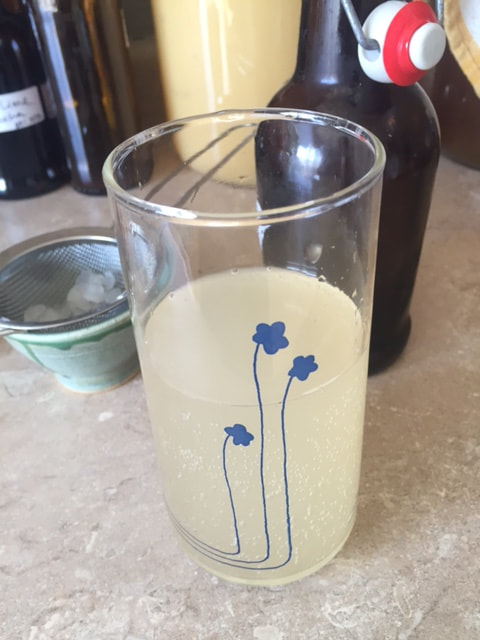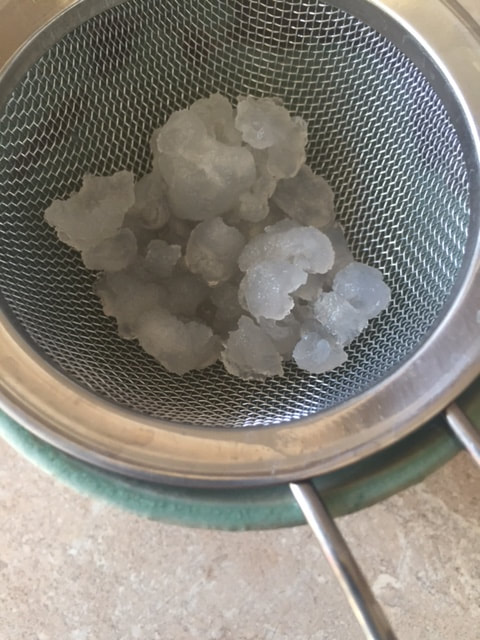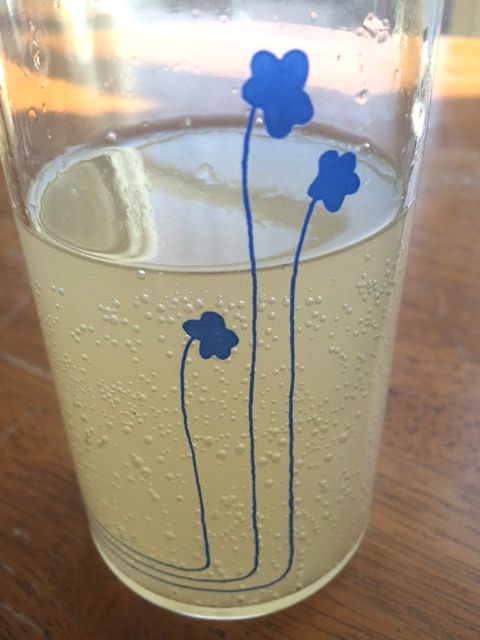|
When people ask me about getting into fermentation, I like to point them towards water kefir as a beginner DIY project. This fermented beverage is not only easy to prepare but is also dairy-free and requires no special equipment. It tends to be a simpler first fermented beverage to try at home, as opposed to kombucha that can be a little trickier to master for some. Kefir, like kombucha, is make from a starter culture that contains a SCOBY, an acronym for “symbiotic colony of bacteria and yeast.” If you’re familiar with a kombucha SCOBY, sometimes called a “mother” culture, you will notice some differences between it and the culture that makes up water kefir. While kombucha is generally one larger, flat culture that forms in layers, the colonies of bacteria and yeast that make up water kefir are in many pieces, forming small, gelatinous balls. These are commonly referred to as kefir grains, which are not grains at all, but are called this due to their appearance. The grains that make water kefir are clear, whereas milk kefir grains are an opaque white, almost resembling cottage cheese curds. What makes kefir different from kombucha, and why the starter cultures themselves look so different, is that they are comprised of different strains of bacteria and yeast. The microbial makeup is different and therefore it is made with a different process and will have different flavors. I like to incorporate as many different fermented foods and beverages as possible into my diet, as diversity in the beneficial bacteria and yeast introduced can have a positive effect on the microbiome, so I like to drink both kombucha and kefir to mix it up. Water kefir takes little time to ferment, which can be nice if you are wanting to get started drinking your product sooner than the 10-14 days it can take to ferment kombucha. Some people prefer water kefir over kombucha because kefir is not made with tea, and those sensitive to caffeine sometimes find kombucha contains too much for them. Water kefir is also great for dairy-free folks who are looking to add more ferments to their life, but can’t eat yogurt or milk kefir. Again, I love and drink lots of kombucha as well as kefir, so I am not saying kefir is superior somehow, but this can be a nice alternative fermented beverage if you find kombucha doesn’t work for you. Because it is made from a SCOBY culture, the trickiest part in making kefir is obtaining the starter “grains.” I find the best way to do this is to get them from a friend or someone in your community who is already making their own. If you can’t think of anyone, maybe throw it out there on social media or on your work bulletin board that you are looking for kefir grains and see if anyone has any to share. Alternately, you can buy them online through the Kombucha Kamp website or Cultures for Health. Once you find some and start making your own kefir, the SCOBY grains will start to grow and reproduce, giving you more than you will need for one batch. You can then divide them up and make multiple batches or share with someone else, storing in the refrigerator in a small amount of prepared kefir until ready to use. Just like when I make kombucha, I like to ferment water kefir with a two-step fermentation process. The first ferment is culturing the sugar-water mixture with the kefir SCOBY, and the second ferment is adding a flavoring and allowing it to carbonate under pressure with the SCOBY removed. For flavors to add during the second fermentation, you can try any juice, fruit puree, or herbs that you like. Favorites at my house are concord grape (made with juice), pineapple-thyme, and ginger-lime. Experiment and see which are your favorites. If you are unsure if you like water kefir and want to try it before getting into making it at home, there are brands available at grocery stores, such as health food stores and co-ops. The brand Kevita makes water kefir, which is most of their products, unless labeled specifically “kombucha.” There are also smaller-scale local brands making water kefir, depending where you live, that would be great to try as well. Of course, I always want to encourage folks to make their own at home if they can! Water Kefir
Makes 1 quart Time: 10 minutes, 3-5 days for fermentation 1 quart filtered water ¼ cup organic cane sugar 10-12 raisins, or 2-3 figs or prunes--the dried fruit is to add some minerals for the SCOBY, which will help it to thrive and grow better, leading to better fermentation and carbonation…kefir grains love minerals 2 Tbs water kefir grains For 2nd fermentation: 2-4 Tbs fruit juice, fruit puree/pieces, or other herb such as ginger or turmeric
0 Comments
Leave a Reply. |
Brine & Broth
I am a gut health-focused nutritionist and online health coach based in Southwest Wisconsin. My recipes and philosophies center around traditional, nutrient-dense foods that support robust gut health. Archives
May 2022
Categories |




 RSS Feed
RSS Feed
